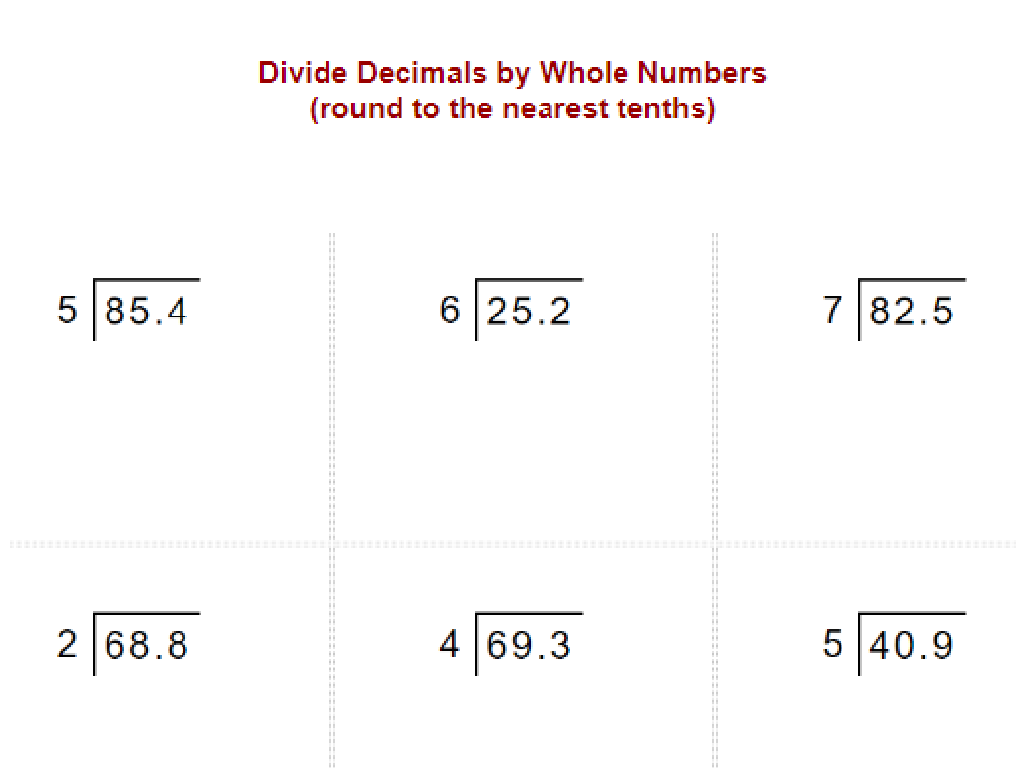Understand An Experimental Protocol About Diffusion
Subject: Science
Grade: Eighth grade
Topic: Designing Experiments
Please LOG IN to download the presentation. Access is available to registered users only.
View More Content
Understanding Experimental Protocols: Diffusion
– Define diffusion in science
– Movement of particles from high to low concentration
– Significance of experimental design
– Experiments validate scientific theories and hypotheses
– Components of an experimental protocol
– Includes hypothesis, materials, methods, and data analysis
– Applying protocols to study diffusion
– Example: Observing dye spread in water
|
This slide introduces the concept of diffusion and its study through carefully designed experiments. Begin by defining diffusion as the process by which molecules move from an area of higher concentration to an area of lower concentration. Emphasize the importance of experimental design in validating scientific theories and hypotheses. Discuss the key components of an experimental protocol, including forming a hypothesis, listing required materials, detailing the methods, and analyzing the data collected. Illustrate with a simple experiment, such as observing how a drop of food coloring diffuses in water, to show how protocols guide the investigation. Encourage students to think critically about each step and how it contributes to the overall success of an experiment.
Understanding Diffusion in Experiments
– Define diffusion process
– Movement of particles from high to low concentration
– Everyday examples of diffusion
– Perfume aroma spreading, sugar dissolving in tea
– Diffusion’s role in biology
– Oxygen transport in lungs, nutrient absorption in cells
– Experimenting with diffusion
|
This slide introduces the concept of diffusion, a fundamental process in both physical and biological systems. Begin by defining diffusion as the movement of particles from an area of higher concentration to an area of lower concentration. Provide relatable examples such as the spread of perfume scent in a room or sugar dissolving evenly in a cup of tea. Explain how diffusion is essential in biological systems, like the transport of oxygen from the lungs to the bloodstream and the absorption of nutrients by cells. Conclude by discussing how students can experiment with diffusion, for instance, by observing food coloring dispersing in water. This will set the stage for a deeper exploration of experimental protocols involving diffusion.
Key Terms in Experimental Design
– Define Independent & Dependent Variables
– Independent variable is changed to observe its effect on the dependent variable.
– Differentiate Hypothesis, Theory, Law
– Hypothesis is an initial assumption, theory is well-tested explanation, law is a statement based on repeated experimental observations.
– Understand Qualitative & Quantitative Data
– Qualitative data describes qualities, quantitative data uses numbers.
– Role of Control in Experiments
– Control is the standard for comparison in an experiment, ensuring that the test results are due to the independent variable.
|
This slide introduces students to the fundamental concepts of experimental design, crucial for understanding diffusion experiments. The independent variable is what the experimenter changes, while the dependent variable is what is observed and measured. Students should grasp the differences between a hypothesis (a testable prediction), a theory (a substantiated explanation), and a law (a descriptive generalization about how some aspect of the natural world behaves under stated circumstances). They should also recognize the difference between qualitative data (descriptive information) and quantitative data (numerical information). Lastly, the control is essential for establishing the experiment’s validity by isolating the effects of the independent variable. Encourage students to think of real-life examples of each term to solidify their understanding.
Stages of Designing a Diffusion Experiment
– Identify the research question
– What do we want to learn about diffusion?
– Formulate a testable hypothesis
– Predict the outcome based on prior knowledge
– Plan the diffusion experiment
– Determine variables and methods for observing diffusion
– Collect and analyze experimental data
– Record observations and measure diffusion rates
– Interpret results and conclude
– Does the data support the hypothesis? What does it tell us about diffusion?
|
This slide outlines the systematic process of designing an experiment on diffusion for eighth-grade science students. Start by identifying a clear question related to diffusion, such as ‘How does temperature affect the rate of diffusion?’ Formulate a hypothesis, like ‘Higher temperatures increase diffusion rates.’ Plan the experiment by deciding on materials, such as colored dye in water, and the method of measuring diffusion. Collect data by observing and recording the spread of dye at different temperatures. Analyze the data to find patterns and interpret the results to draw conclusions about the relationship between temperature and diffusion. Encourage students to think critically at each stage and understand that experiments are iterative processes that can lead to new questions and hypotheses.
Understanding Experimental Protocol in Diffusion
– Define experimental protocol
– A set of procedures to conduct an experiment
– Protocol’s role in reliability
– Ensures consistent, repeatable results
– Key components of a protocol
– Includes hypothesis, materials, methods, and data analysis
– Applying protocol to diffusion
– Example: Measuring rate of sugar dissolving in water at different temperatures
|
This slide aims to introduce students to the concept of an experimental protocol and its significance in scientific experiments, particularly in studying diffusion. An experimental protocol is a blueprint for conducting research that ensures consistency and reliability. It’s crucial for students to understand that without a well-defined protocol, experiments can yield unreliable results. The components of a solid experimental protocol include a clear hypothesis, a list of necessary materials, a detailed method section, and a plan for data analysis. To illustrate the application of an experimental protocol, use the example of measuring the rate of sugar dissolving in water at different temperatures, which demonstrates diffusion. Encourage students to think about how changing variables can affect the outcome and the importance of documenting every step for accurate replication and analysis.
Diffusion Experiment Protocol
– List of required materials
– Beakers, food coloring, water, stopwatch
– Follow step-by-step instructions
– Add coloring to water, observe, record time
– Adhere to safety measures
– Wear safety goggles, handle glassware carefully
– Understand precautions
– Avoid skin contact with chemicals, clean spills
|
This slide outlines the protocol for a diffusion experiment. Students will need beakers, food coloring, water, and a stopwatch. The experiment involves adding a drop of food coloring to water and observing the diffusion process, timing how long it takes for the color to spread evenly. Safety is paramount; students should wear goggles and handle all materials with care. They should also be aware of how to deal with any spills and avoid skin contact with chemicals. The teacher should supervise the experiment at all times, ensuring that students follow the protocol and maintain a safe environment.
Predictions and Observations in Diffusion Experiments
– Making predictions from hypotheses
– Predict outcomes based on initial theory
– Observing diffusion in action
– Watch and note how substances mix over time
– Recording qualitative data
– Note descriptive data, like color changes
– Recording quantitative data
– Measure data, such as concentration changes
|
This slide focuses on the steps of making predictions and observations in a diffusion experiment. Students should understand that predictions are educated guesses based on their hypotheses about how the diffusion will occur. Observations involve closely watching the diffusion process, which could be demonstrated with a simple experiment such as food coloring spreading in water. Students should record qualitative data (descriptive observations like changes in color or form) and quantitative data (numerical measurements like rate of diffusion or concentration gradients). Encourage students to be meticulous in their recording, as this data will be crucial for analyzing the results of their experiments.
Analyzing Experimental Data on Diffusion
– Analyze diffusion experiment data
– Examine changes over time, note any trends
– Recognize patterns and relationships
– Look for consistent behavior in the data that points to how diffusion occurs
– Use data to evaluate hypothesis
– Compare the experimental results with the predicted outcome
– Discuss findings and conclusions
|
This slide focuses on the steps necessary to analyze data collected from a diffusion experiment. Students should learn how to observe and interpret the data to identify any trends or patterns that emerge during the process of diffusion. They should understand how to use these observations to support or challenge their initial hypothesis. It’s crucial to guide them on how to present their findings logically and coherently, discussing the implications of their results and what they suggest about the diffusion process. Encourage students to think critically about the data and to consider alternative explanations for their observations.
Drawing Conclusions from Diffusion Experiments
– Interpret the experiment’s results
– Analyze data to understand the diffusion process
– Relate findings to the hypothesis
– Does the data support or refute our initial prediction?
– Discuss potential experimental errors
– Identify any factors that may have skewed the data
– Consider implications of results
– How do our findings impact our understanding of diffusion?
|
This slide aims to guide students through the final steps of the scientific method: drawing conclusions. Students should learn how to look at their experimental data and understand what it tells them about the process of diffusion. They need to compare their results with the original hypothesis to see if it holds true. It’s also crucial to discuss any errors that could have occurred during the experiment, such as measurement inaccuracies or uncontrolled variables, and how these might affect the results. Finally, students should think about the broader implications of their findings on the understanding of diffusion and how it applies to real-world scenarios. Encourage students to think critically about their experimental design and results, fostering a deeper comprehension of scientific inquiry.
Class Activity: Observing Diffusion
– Conduct diffusion experiment
– Observe food coloring spread
– Watch how the color moves through the water
– Record observations
– Note the speed and pattern of diffusion
– Discuss findings in groups
– Share and compare results with classmates
|
This class activity is designed to give students a hands-on experience with diffusion. Provide each student or group with a clear container of water, and have them add a drop of food coloring without stirring. They should observe how the color spreads through the water, which is diffusion in action. Encourage them to take notes on how quickly the color spreads and any patterns they notice. After the observation period, facilitate a group discussion where students can share their observations and discuss the factors that might affect the rate of diffusion, such as temperature or concentration gradients. Possible variations of the experiment for different groups could include changing the water temperature, using different colors to see if they diffuse at different rates, or using other substances like perfume to observe diffusion in the air.






